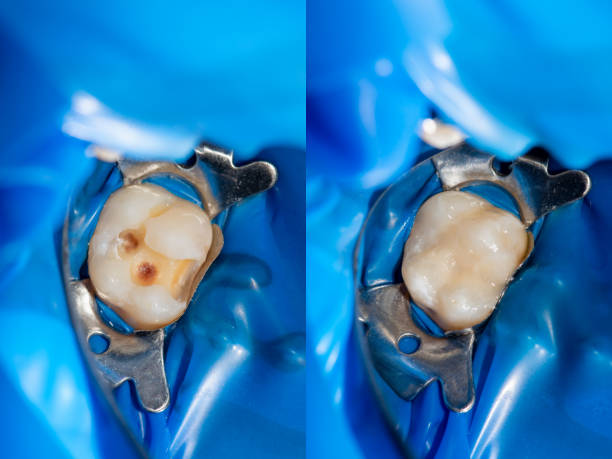Brushing and flossing are the most important and efficient ways to help protect teeth from getting cavities. Good oral health can be achieved by simply doing these things twice a day. However, brushing and flossing does not ensure cavities will not eventually appear over time. Anatomically, teeth have pits, fissures, and grooves that can make brushing the chewing surfaces of our teeth a little more difficult. Over time, due to these grooves and bumpy surfaces on our teeth, our teeth may be more prone to cavities on the surfaces. Since the toothbrush cannot reach into all of the nooks and crannies of the surfaces of our teeth, we need to place a protective coating on those chewing surfaces. These protective covers are called sealants. (Pictured on the right)

How do sealants work?
Bacteria living in our mouth is very natural but can be problematic if oral hygiene is poor. These bacteria will feed on the leftover food and sugars we eat and produce acids that make little holes (cavities) in our teeth. By applying sealants on the chewing surfaces of the teeth, it becomes much harder for the acids from the bacteria to create cavities. In fact, according to the CDC in 2016, dental sealants prevent 80% of cavities in the back teeth where 9 in 10 cavities occur. While sealants may not be able to ensure cavities will not form, they are an extremely effective preventative measure and will stop the progression of tooth decay.
When to get sealants
Anyone is a candidate for sealants – children and adults! The sooner you can get them, the better. Children will get their first set of permanent (adult) molars when they are 6 years old, and their second set of permanent molars when they are 12. Sealing these molars as soon as they erupt is the most beneficial in preventing cavities on the surfaces of our teeth, especially if the surfaces of their teeth are more susceptible to cavities. Although molars are the most commonly sealed teeth, other teeth may be sealed as well if needed. Asking your pediatric dentist about sealants and if your child needs them will be the first step in furthering the prevention of cavities.
How are sealants placed?
Applying sealants is a very straightforward, easy, and painless procedure, requiring no drilling or numbing, and can take anywhere from 5 to 15 minutes to complete! First, the tooth is prepped, cleaned, and dried with an acidic gel-like material called ‘etch’. Etch will clean the enamel and will make sure the sealant forms a very strong bond with the tooth. After prepping the tooth with etch, the sealant is applied. Sealants can be thought of as paint; we simply apply the sealant to all of the pits, fissures, and grooves in the teeth and spread it out with a little brush. After this, it is cured again to make sure the liquid sealant hardens and sticks to the tooth.

After getting sealants
After the sealants are applied, children will be able to notice them just for a day or two, due to the chewing surfaces of the teeth being a little different. Sealants can last up to 9 years (CDC, 2020). Because sealants can crack, fall off, or become worn down due to eating sticky foods or grinding, it is important to attend regular check ups and cleanings to ensure that the sealants are still intact, and reapplied when necessary.

